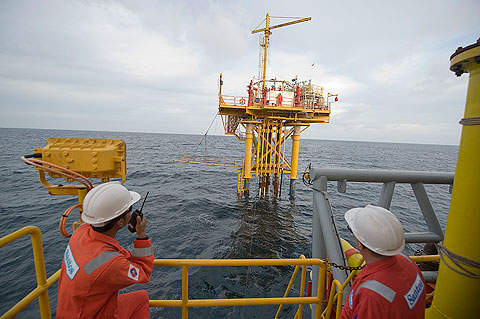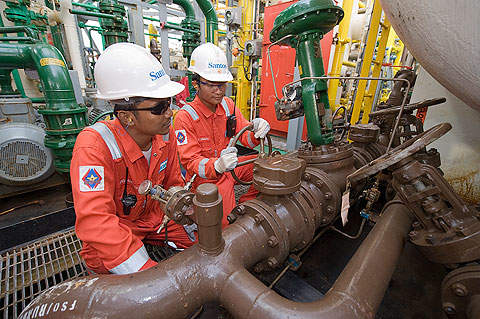The Oyong oilfield is situated 8km off the coast of Madura Island in the East Java region of Indonesia. Located at a water depth of 45m, the field has a gas column of 120m and an oil column of 38m. The field is estimated to hold about eight million barrels of oil and 130bcf of gas reserves.
Discovered in August 2001, the Oyong field is operated by Australia-based Santos. The company owns a 45% stake in the field and the remaining interest is held by Singapore Petroleum (40%) and Cue Energy (15%).
The Oyong field’s first oil production occurred in September 2007 and its first gas in October 2009. Oil is processed at the Sea Good 101 production barge and loaded onto the Shanghai floating storage and offloading (FSO) for storage and export.
Sea Good 101 production barge
The Sea Good 101 was originally an FPSO built at the Guangxi Wuzhou shipyard in 1998.
Owned by Sabre System International, the FPSO was converted into a barge by adding new facilities such as a high-pressure separation train for oil and water processing and a high-pressure gas compression train to compress and re-inject gas into the reservoir.
Oyong wellhead platform
Oil from the Oyong field is produced using an offshore wellhead platform. The Ocean Sovereign jack-up drilling rig was used to install the platform. The triangular wellhead platform consists of a tall template structure, a stacked template structure, a conductor pile and a wellhead deck.
The TTS was installed on the seafloor in 41m of water. The wellhead deck is supported by piles driven through the three legs of the TTS. Five oil and two gas production wells were installed.
Shanghai FSO
The Shanghai FSO vessel was built by Tanker Pacific in 1982 and was converted at the Keppel Shipyard in Tuas, Singapore, for use at the Oyong field. Conversion works on the vessel included the installation of a custody transfer metering system and a tandem offloading system.
The design life of the vessel was extended by ten years. In addition, some of the ballast tanks were converted into cargo tanks to increase its storage capacity.
The vessel features a spread mooring system and has a deadweight of 47,803t. It has an overall length of 182m and moulded breadth of 32m. It features one 10t crane and can accommodate a crew of 50.
The vessel’s crude oil storage capacity is 373,332 barrels with a maximum loading rate of 25,000bpd and export rate of 15,000 barrels per hour.
Oyong field development
The Oyong oilfield was discovered following the drilling of the Oyong-1 exploration well in May 2001. Two wells, Oyong-2 and Oyong-3, were drilled subsequently in June 2001 and October 2001. The wells demonstrated the presence of substantial commercial reserves for the development of the field.
The Institute of Natural and Regional Resources conducted the environmental impact assessment of the field. In November 2003, the Indonesian Government approved the development plans for the field. A revised development plan to begin oil production was approved in April 2005.
Development of the Oyong field is being carried out in two phases. Phase I includes the production of crude oil using the Sea Good 101 production barge.
Associated gas is separated and injected back into the reservoir using the barge. Production rates of the field range between 8,000-10,000bpd.
Phase II of the field development was approved in December 2007 and includes the modification of the offshore facilities and construction of a 60km, 14in-diameter pipeline. The pipeline will be used to supply gas to a processing plant situated near the Grati power station in East Java.
Oyong oilfeld’s gas production rates are estimated to be between 50 and 60mscf per day during the plateau period.
Santos signed an agreement with PT Indonesia Power in July 2003 to supply all its gas reserves to the latter. The gas will be used at the Grati power station.
Oyong contracts
In 2005, Pulau Kencana Raya was awarded the contract to convert the Sea Good 101 into a production barge. In 2006, the company fitted additional equipment required by Santos to the barge. Zee Engineering Consultants provided engineering services for the Sea Good 101 conversion.
AML Consultants provided consulting services for mooring Sea Good 101. The company carried out the eight-leg chain mooring of the barge with drag anchors.
AML subcontracted Foundation QA to provide assistance with the mooring and anchoring of the barge. Foundation QA reviewed the anchoring mechanism proposed by Vryhof, which involved the use of Vryhof’s Stevpris New Generation anchor.
Foundation QA examined the geotechnical conditions at the anchor sites and developed a geotechnical model. The company assessed the anchor holding capacity and reviewed the anchor installation.
It also provided assistance on the fluke angles, which helped in completing the installation of the anchors.
Geospecialist was awarded a contract to carry out a magnetometer survey for the anchor of the FSO and pipeline for the Oyong field. Aquila Mooring Solutions provided design assistance for the FSO mooring system.
ICON Engineering designed the Oyong wellhead platform. H&H Utama International constructed the TTS and STS of the Oyong wellhead platform.






